Wikipedia:Reference desk/Archives/Science/2019 June 16
| Science desk | ||
|---|---|---|
| < June 15 | << May | June | Jul >> | June 17 > |
| Welcome to the Wikipedia Science Reference Desk Archives |
|---|
| The page you are currently viewing is an archive page. While you can leave answers for any questions shown below, please ask new questions on one of the current reference desk pages. |
June 16[edit]
Does the universe have an electric charge ?[edit]
That is, does the number of protons and electrons equal one another, or are there more protons, giving the universe a positive charge, or more electrons, leading to a negative charge ? And if the number is roughly equal, is there some regulating force that causes this, or is the reason unknown ? SinisterLefty (talk) 13:04, 16 June 2019 (UTC)
- This question has been asked at Quora where various replies depend on assumptions about the size of the Universe. If the universe is finite, then it seems impossible to have a never-ending electric field line, so it seems that a finite universe must be charge neutral. If the universe is infinite, and has a uniform nonzero charge density through its infinite expanse, then it has an infinite net charge. Then every part of the universe is a source of some never-ending electric field lines. DroneB (talk) 13:26, 16 June 2019 (UTC)
- standard cosmological model works like the universe has no net charge. If it had, the repulsion between same charge would need to be taken into account to explain expansion of the universe, which is not done AFAIK.
- see also: electric_charge#Conservation_of_electric_charge
- Also, the universe seems conductive enough to act like this (from Electrostatics#Electric_field):

So, are any theories proposed for what would explain this exact match in the number of protons and electrons ? SinisterLefty (talk) 19:22, 17 June 2019 (UTC)
- Not sure you need to explain that, because this is the simplest solution you can imagine, and you'll some symmetry breaking for the number to be different. But don't trust my word on this, this math is far above my grade. Gem fr (talk) 19:54, 17 June 2019 (UTC)
- There are other charged particles than protons and electrons so the net charge can be zero without a perfect match of those particular particles. And a proton is a composite particle composed of three valence quarks: two up quarks of charge +2/3e and one down quark of charge –1/3e. PrimeHunter (talk) 20:30, 17 June 2019 (UTC)
Thanks all. SinisterLefty (talk) 18:09, 23 June 2019 (UTC)
